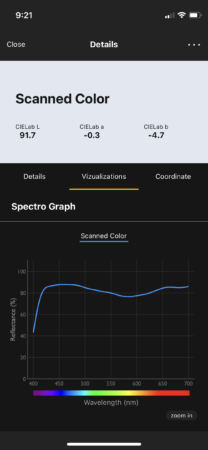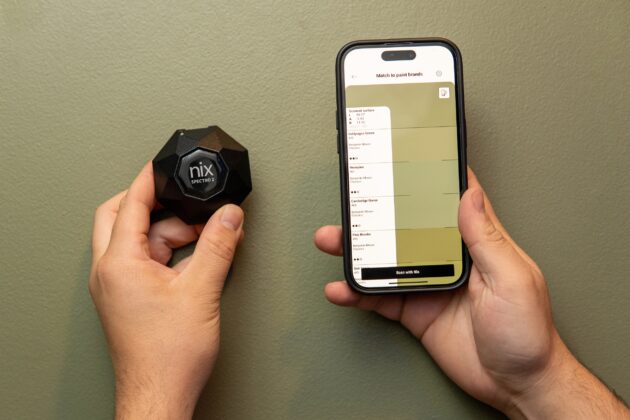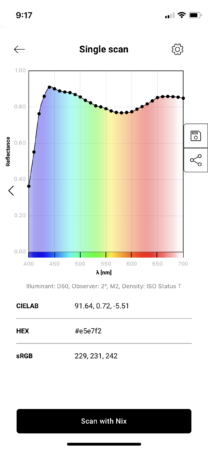
Features
Opinion
Tech
Wide Format Week
A colourful revolution
A new generation of phone-based spectros are disrupting measurement processes
October 2, 2023 By Abhay Sharma
 The Nix Sensor connects to your phone and allows matching of colour samples to Pantone colours or Sherwin Williams and other paint companies. Photos © Abhay Sharma
The Nix Sensor connects to your phone and allows matching of colour samples to Pantone colours or Sherwin Williams and other paint companies. Photos © Abhay Sharma Started by a group of McMaster graduates, Nix Sensor in Hamilton is a 25-employee organization that designs, fabricates, assembles, tests, and ships colour measurement devices to customers ranging from paint companies to cosmetics. Nix recently launched the Spectro 2, a fully functional low-cost spectrophotometer. Matthew Sheridan is the founder and CEO. He has assembled a team that has created game-changing, phone-based instruments; you’ll get the picture if you watched the recent Blackberry movie.
Measuring devices
In my Colour 101 class, I describe three categories of colour instrument: densitometer, colorimeter, and spectrophotometer (the names are indicative of what they measure). In printing, traditionally density measurements are used to monitor ink amounts on press. Recently, instruments and press consoles have migrated to better, more visually relevant metrics, primarily L*a*b*. A spectrophotometer (spectro) measures the spectrum of a printed colour which allows us to compute L*a*b* (and any other desired metric). A spectro is “backward compatible,” as it can report L*a*b* while also allowing readout of old-fashioned print density.
Spectral data is the uber data type, and the holy grail of colour measurement. It enables us to do many colour calculations, such as predict metamerism to see if the colour of a product on a supermarket shelf will change when exposed to outdoor natural light. Spectral data allows for efficient spot colour matching. The spectrum allows us to take into account different light sources such as daylight D50, fluorescent lights (F Illuminants), or LEDs.
Until recently, to get spectral data, a user had to buy a $10,00+ handheld or scanning spectro.

Nix Toolkit and Variable Spectro represent a new generation of phone-based colour instruments. Measurements can be easily shared via text or email or used within an app to match paint or Pantone colours.
Phone-based spectros
An exciting development in colour measurement is a new generation of lightweight, low-cost, durable spectros that tether to smartphones. At Toronto Metropolitan University, we studied two new-generation smartphone spectros, the Nix Spectro 2 (CD$1339) from Hamilton and Variable Spectro 1 (CD$400) from the U.S. The Nix and Variable spectros were simple and easy to use; they have apps that were effortlessly downloaded from the app store. Measurement data was a one-click export via text or email. Data was plotted within minutes.
Colour difference is technically described in terms of Delta E. Typically, a value between 1-2 Delta E is acceptable in printing. In our testing, we noted around a 1 Delta E colour difference between the low-cost instruments and the $10K+ handheld model.
Phone spectros are a great idea as they rely on your phone for display. The app can be easily updated, and computation is done using your phone’s processing power. Everybody owns a phone these days. Apps can take the measured colour and assist a designer in finding complementary, analogous, opposite colours, shades, harmonies, trends, palettes, etc. The spectros have licenses for spot colour libraries and are therefore able to measure a colour and give you the nearest Pantone match. App developers can go wild with data from these devices.
Further, colours are displayed on a tablet or smartphone in much better fidelity compared to the LCD panel of a hand-held instrument. Connection to the device via Bluetooth, and from the phone to the internet, makes two-way communication a breeze.
The Nix sensor has found huge success in helping customers choose and match paint. In a real-world application, when a burst pipe in the author’s home needed dry wall repair and painting, a Nix Spectro 2 was used to measure the colour of the wall and the app showed the nearest Dulux paint colours with one, two or three stars to indicate best matches. With the user-selected preference, all that was needed was for the painter to estimate the amount of paint needed and a quick bike ride to the local Dulux store with the SKU to get ready for a colour accurate repair job.
M1 and M2 measurement modes
The whole colour measurement industry (both handheld and phone spectros) have contended with two major changes in colour measurement: UV-excited optical brighteners as well as measurement of textiles and fabrics.
UV-excited optical brighteners are widely used in printing papers. To deal with colour measurement of optically brightened papers and to reduce inter-instrument differences, there are standard measurement modes: M1 (UV included) and M2 (UV excluded). M1 is equivalent to D50 lighting and is the preferred measurement mode in the graphic arts. The Variable Spectro 1 only measures in M2 mode, which is a limitation if intended for use in the printing industry.
The other change in instruments is due to the need to measure colour on textiles and fabrics. The weave or thread count is very coarse compared to a halftone printed dot or tiny inkjet droplet. Instrument manufacturers were forced to create larger measuring apertures, 2 mm for print samples but often 5 mm for colours printed on cloth. Some instruments have interchangeable apertures. The Nix Spectro 2 comes in 2 mm and 5 mm sizes while the Variable Spectro 1 is only available in an 8-mm aperture size.

When a burst pipe in the author’s home needed dry wall repair and painting, the Nix Spectro 2 was used to find the closest Dulux paint colour.
Colourful applications
The low price of phone spectros means that we don’t mind their use in a range of dirty situations, such as measuring the colour of raw meat in meat processing plants, wastewater liquids, or nicer liquids such as wine. The consumer can measure and match paint for home decor.
The development of low-cost spectros, linked to our smartphone, has created an infinite range of opportunities to advance the use and integration of colour into design and equally exciting technical and scientific applications.
Acknowledgement: The author is grateful to Nix Sensor for review devices provided for testing and evaluation and to Sasha Blay for proofreading and copy editing.
Abhay Sharma is a Professor in the School of Graphic Communications Management at Toronto Metropolitan University, Toronto, and author of Understanding Color Management, Wiley, 2018.
This article originally appeared in the July/August 2023 issue of PrintAction.
Print this page
